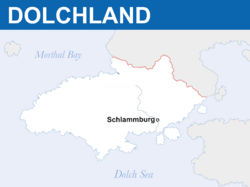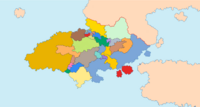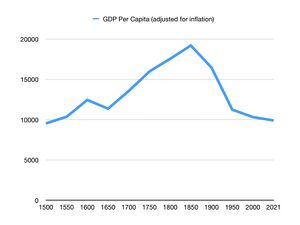Dolchland
Empire of Dolchland Dolchland | |
|---|---|
 Map of Dolchland | |
| Capital | Schlammburg |
| Largest city | Morthal |
| Official languages | Alemannisch |
| Government | Elective Monarchy |
• Emperor | Heinrich Johannes von Ausburg |
| Legislature | Imperial Diet |
| Diet of Electors | |
| Establishment | |
• Establishment of the Empire | 1777 |
| Area | |
• Total | 342,920 km2 (132,400 sq mi) |
| Population | |
• 2018 estimate | 29,283,179 |
| GDP (nominal) | 2018 estimate |
• Total | $289,991,321,637 |
• Per capita | $9,903 |
| HDI | .600 medium |
| Currency | Thaler |
| Driving side | left |
This article or section is in the process of an expansion or major restructuring. You are welcome to assist in its construction by editing it as well. If this article or section has not been edited in several days, please remove this template. If you are the editor who added this template and you are actively editing, please be sure to replace this template with {{in use}} during the active editing session. Click on the link for template parameters to use.
This article was last edited by Orioni (talk | contribs) 4 days ago. (Update timer) |
Dolchland, also known as the Dolch Empire, is a country located in southeast Argis. Its closest neighbours are Seylos and Ceris to the south, Velaheria to the north, Stedoria to the north-west, and Delamaria and Fravina to the north-east. The capital of Dolchland is Schlammburg, however the largest city is Morthal. The nation has a population of 28 Million, divided among its 40 constituent states. With varying degrees of power and importance, Dolchland's constituent states are fairly independent, with only a common Emperor, external foreign policy and law to unite them. Individual states usually maintain their own militaries and are almost all hereditary monarchies.
Dolchland has declined in recent decades, with a low GDP per capita, and widespread inequality between the ruling aristocracy and the common people. There have been several attempted revolutions in Dolchland's history, however most have been put down with force. Democratic parties are present in most states of the empire; however, they are banned in some regions, and where they are allowed they are subject to constant raids and abuse by the local governments.
Etymology
Alemannisch for 'Daggerland'. German Dolch is said to come from either the !Latin Dolo for “to cut”, or Proto-German dalkaz for “knife”. This is a reference to a good place where trees are cut. It might also be a warning against being cut down by the local inhabitants. Describe a text that holds the very first mention of the name. Also add a brief list of some foreign names for Dolchland. For example: Dalitalēni in Orioni.)
Geography
The country's geography is vast and varied, with some areas being extremely mountainous, others being noxious bogs, and others being old forests from before the time of man. Of note, only the southern parts of the country have moderately mild summers and winters. The rest of the country tends towards mild summers and harsh winters, with snowfall and thick freezing fog being a constant issue for much of the year. Due to its geographical location, much of the Æitiastain region suffers from thick rolling fog, near constant rain, and thunderstorms during the fall wet season. This is caused by warm and wet air being forced above cooler air by storm systems coming off of the Adlantic Ocean. The resulting pressure and potential differentials lead to electrostatic discharges being rather common for the season, and cool air filled with moisture condensing near the ground.
Special note should be given to the mountain range in the north of the country. The Apf Kadirn-Gebirge are truly massive, with onf of the largest mountains in the world, Jokultitbjarg, rising in them. They are of quite a large amount of historical importance, as wars have been won and lost over the control of passages through them.
History
- 1100s: Walneria was originally inhabited by Slavic peoples from south-central Argis. However, in the 12th century, Dolchic peoples from the empire began a migration to where modern Walneria is in a movement known as the “Westsiedlung”. While Walneria was never integrated into the Empire, this policy of settlement and cultural exposure resulted in a society being mainly Dolch in culture, though not fully in ethnicity. Eventually, the now Dolch ruling groups in the region came together to form the Kingdom of Walneria.
- 1500s: In the 16th century, the then Dolch Empire began colonisation efforts in Aurelia, hoping to exploit new lands for their continued growth. The primary resource that the Dolch were after were gold reserves that the native Aurelian civilisations appeared to have an abundance of. However, these colonies ran into significant issues as the native populations were hostile to the Dolch presence in the region. The Dolch followed their initial colonisation with a series of local conquests which expanded the reach of the Rhodellian colonies. However, by the 18th century, the empire deemed the colonies as too expensive to maintain and allowed a vote for independence, resulting in the creation of the Kingdom of Rhodellia.
- 1568: The Stedorian people come from Dolchic peoples who migrated from where modern day Dolchland currently exists; they intermingled with the original inhabitants of Stedoria, adopting their language but keep their Dolchic customs. Eventually, this land came under the loose control of the Dolch Empire but in 1568, the Kelvön dynasty formally broke from the empire creating an independent Stedoria.
- 1617-1623: The Vethringen Succession War takes place. While ostensibly about succession, the war takes on far more religious undertones. The war results largely in a stalemate, with neither side truly succeeding in their aims, but the authority of the Emperor is seen as strengthened by the war.
- 1641: In 1641 the Dolch Empire would attempt a second colony in Aurelia, close to the location of modern-day Volta. Its first colonisation attempt was met with resistance by the Crescent Empire, which ended in the total destruction of the colony.
- 1777: The Empire of Dolchland is formally established with an elective imperial monarchy.
- 1790s: By the end of the 18th Century, the powerful Empire of Dolchland reached its zenith. It that controlled vast lands of East Argis, expanding into Central Argis. Its increasing population made it the largest economy in the region.
- 1795-1797: The War of the Habstrian Succession takes place, involving all the Dolchic Kingdoms and many of the smaller states.
- 1810: However, by 1810, another power took the Volta colony.
- 1875: By 1875 Volta gained its independence.
- 1890s: By the end of the 19th Century ended, the golden years of Dolchland were long gone. The country suffered from social unrest, foreign interventions and economic problems. Dolchland had become a sick state in Argis. With an iron fist, Emperor $PersonName managed to tried to keep his country together.
- 1959: 1959 Schlammburg Crisis. Stand-off between Habstria and Imperial forces, against Panedonia and aligned states.
- 2022: Quiet War: Habstrian Emperor Heinrich Johannes von Ausburg exercises a brief and mostly bloodless military campaign against Panedonia and its allies, consolidating Imperial power. This effort was supported by Great Anglia as the nation continued to build its influence in Argis.
Ahrana
Ahrana has a history of trade and royal relations with Dolchland. In recent times, a former Ahranian noble married into the Imperial family and became consort of the Emperor.
Seylos
Seylos has had a long history of conflict with Dolchland. Dolch pirates have existed in the waters around Seylos and Ceris for centuries, leading in the past to frequent naval engagements. The island of Ceris had also brought much conflict as well, since both were attempting to gain favour with or possibly extend their territory into the island. In the west, Dolchic settlers spread forth and from the east, peoples from Seylos did the same. Conflict was common in Ceris until the unification of most of the island under the Hodrean Kingdom, which remained lukewarm at best with Seylos and hostile with Dolchland.
Delamaria
Before the founding of Delamaria, some lands in the South west were under the control of the Dolch Empire. There were attempts at Dolchic colonisation further east and north, however native resistance and a series of bad harvests deterred these. Few remnants remain of these Dolchic territories in Delamaria. The only region with a Dolchic official language is the Grand Barony of Wittelsburg-Hampdorf, a small autonomous protectorate and the only part of Delamaria with a hereditary ruler. Through Delamaria's royal and imperial eras, the nations maintained good relations, with marriages being common between Dolchic and Delamarian royals. Dolchland has been critical of Delamaria since the collapse of the monarchy, and is a supporter of the Delamarian monarchist movement.
Politics

The empire of Dolchland consists of 5 Kingdoms, 13 Duchies, Landgraviates, and Electorates and 9 Baronies. Dolchland is an elective monarchy, meaning that when the reigning emperor dies, the Diet of Electors is called to elect a new head of state. The members of the Diet are the monarchs and leaders of Dolchland's constituent states, each with varying amounts of votes in the election depending on the size and power of their domain. The current Emperor is His Imperial Majesty, Heinrich Johannes von Ausburg, who also reigns as the King of Habstria. He is the nephew of the previous emperor, Friedrich Johannes von Ausburg. The Ausburg Dynasty has ruled since 1777,[1] projecting Habstrian power across the empire. However, other kingdoms have become increasingly aligned with one another, especially Panedonia, threatening the power of the Habstrian kings over the Imperial throne.
Economy
(Energy. Industry. Infrastructure. Transport.)
Demographics
Language
The Dolch language, also known as Alemannisch, is an ancient linguistic variant that has undergone significant transformation throughout history, from the Old Dolch to the Modern Dolch era. Originating in the Early Middle Ages, Dolch is thought to be a language that developed among the Alemanni tribes inhabiting the regions of what is now northern Dolchland, Velaheria, and Stedoria.
Old Dolch (6th Century - 9th Century)
Old Dolch emerged in the 6th century CE and lasted until the late 9th century. The linguistic features of Old Dolch were predominantly characterised by strong influence from the East Argic language family, notably Old High Alemannisch. The language was initially spread and used primarily by the Alemanni, a group of Dolchic tribes, to communicate among themselves and with neighbouring tribes.
Old Dolch script utilised Elder Futhark runes before transitioning to the Aroman alphabet under Christian influence. Textual records from this period are scarce, and most of what we know about Old Dolch comes from inscriptions, artefacts, and references in Aroman texts.
Middle Dolch (9th Century - 14th Century)
The Middle Dolch period spans from the late 9th to the 14th century. This era saw an increased influence from the Middle High Alemannisch language, leading to structural and lexical changes in Dolch. Notable shifts during this period include the reduction of unstressed vowels, simplification of the case system, and the introduction of new prepositions and conjunctions.
Middle Dolch was also marked by a significant increase in written records, indicating a broader acceptance of the language in administrative and religious contexts. The earliest known literary work in Middle Dolch is “Das Alemannische Lied,” an epic poem from the 10th century.
Modern Dolch (14th Century - Present)
The transition to Modern Dolch around the 14th century saw a surge in the language's use in literary and scholarly works, as well as its gradual spread into everyday vernacular. Modern Dolch shows further simplification of the grammatical system, with a notable shift towards analytical structures.
Modern Dolch also exhibits significant influence from Modern High Alemannisch due to increasing political and cultural exchanges. Moreover, loanwords from Laimaic, Lysian, and Cristinese languages also began to be incorporated, reflecting the region's evolving political landscape and cultural interactions.
In recent centuries, Modern Dolch has faced significant pressure due to the spread and dominance of standard Anglish, resulting in its glubal categorisation as a minority language. However, efforts towards preservation and revitalisation have been ongoing, with the language still spoken in rural and traditionally Alemannic areas. Modern Dolch also continues to be a subject of study for linguists and historians interested in its rich linguistic history and unique features.
It's important to note that this portrayal of Dolch as a distinct language throughout the centuries is a hypothetical and academic one. As with any language, Dolch likely featured various dialects and underwent many changes influenced by socio-political factors and contact with other languages. The delineation of Old, Middle, and Modern Dolch is a simplification that allows for easier study and understanding of the language's development over time.
Culture
Cuisine
Historically, a staple part of the Dolchlander diet was müd, a thick rye and beetroot soup or stew. It was eaten by almost all the strata of Dolchlander society, from the lower classes and to even the aristocracy. Although often considered bland and having something of an earthy flavour, it often had various meats and other vegetables added, depending on season or availability. It has been replaced by other starches, such as the potato, in more recent years, but it remains a key part of Dolchlander identity, one that spreads across all the states of the country. There are several regional variations, such as the schollemüd, made with fried and shredded fillets of Dolchic plaice and eaten in eastern Panedonia or hügelmüd, a variety made with smoked cheese and typically eaten in the hilly north of Wurveria. Similar variations, referred to as käsemüd are found across the upland regions of Gmunenhochwald. However, the basic recipe remains the same across Dolchland.
It is thought that the soup inspired the pejorative term for Dolchlanders, “mud-” or “dirt-eater”. Foreigners to the country would see the locals tucking into bowls of thick, brown soup and see a likeness to the thick, brown mud of the fertile lands of Dolchland. It is a term that is generally used to portray the Dolchlanders as an ignorant, backward people. This flies in the face of the history as a land of explorers and settlers, although it has been suggested that one of the reasons that they spread so far was to find better things to eat.
References
- ↑ The Kings of Habstria have ruled Dolchland as Emperors since 1777, with interruptions between 1827 and 1901.



